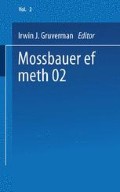Abstract
The use of the Mössbauer technique as a solid-state tool is inherently concerned with the nature of the electric and magnetic interactions experienced by the emitting or absorbing recoil-free atom. Indeed, the majority of Mössbauer studies have centered around investigations of electric and magnetic hyperfine interactions and the electron—nuclear interaction leading to the isomer shift. Until recently, most studies of this type have involved systems in which the time-independent features of the hyperfine interactions were emphasized, and the observed electronic fields given a simple classical interpretation. The prime example here is, of course, the effective internal magnetic field found in magnetically ordered compounds.
Access this chapter
Tax calculation will be finalised at checkout
Purchases are for personal use only
Preview
Unable to display preview. Download preview PDF.
References
A. J. F. Boyle and H. E. Hall, Rept. Progr. Phys. 25: 441 (1962).
A. Abragam and R. V. Pound, Phys. Rev. 92: 943 (1953).
A. Abragam, Principles of Nuclear Magnetism (Oxford University Press, London, 1961 ).
A. Abragam and M. H. L. Pryce, Proc. Roy. Soc. (London) A205: 135 (1951).
J. A. Pople, W. G. Schneider, and H. J. Bernstein, High-Resolution Nuclear Magnetic Resonance (McGraw-Hill Book Company, New York, 1959 ).
H. S. Gutowsky, R. L. Vold and E. J. Wells, J. Chem. Phys. 43:4107 (1965) and citations therein.
G. K. Wertheim and J. P. Remeika, Phys. Letters 10:14 (1964); Proc.)(filth Colloque Ampère, ( North Holland Publishing Company, Amsterdam, 1965 ), p. 147.
C. R. Kurkjian and D. N. E. Buchanan, Phys. Chem. Glasses 5: 63 (1964).
G. Lang and W. Marshall, Proc. Phys. Soc. (London) 87: 3 (1966).
F. E. Obenshain, L. D. Roberts, C. F. Coleman, D. W. Forester, and J. O. Thomson, Phys. Rev. Letters 14: 365 (1965).
S. Ofer, B. Khurgin, M. Rakavy, and I. Nowik, Phys. Letters 11: 205 (1964).
R. L. Cohen, Phys. Rev. 137: A1809 (1965).
H. Dobler, G. Petrich, S. Hüfner, P. Kienle, W. Wiedeman, and H. Eicher, Phys. Letters 10: 319 (1964).
A. Hillier, W. Wiedeman, P. Kienle, and S. Hüfner, Phys. Letters 15: 269 (1965).
M. J. Clauser, E. Kankeleit, and R. L. Mössbauer, Bull. Am. Phys. Soc. 10: 1202 (1965).
H. H. Wickman and G. K. Wertheim, in Chemical Applications of the Mössbauer Effect, edited by V. Goldanskii and R. H. Herber, Chap. 11.
A. J. Freeman and R. E. Watson, in Magnetism,Vol. IIA, edited by G. T. Rado and H. Suhl (Academic Press Inc., New York, 1965), Chap. 4.
H. H. Wickman and I. Nowik, Phys. Rev. 142: 115 (1966).
R. J. Elliott and K. W. H. Stevens, Proc. Roy. Soc. (London) A218: 553 (1953).
W. Low, Paramagnetic Resonance in Solids (Academic Press Inc., New York, 1960 ).
H. H. Wickman and G. K. Wertheim, Phys. Rev. 148: 211 (1966).
A. M. Afans’ev and Yu Kagan, Zh. Eksperim. i Teor. Fiz. 45:1660 (1963) [Soviet Phys. JET? (English Trans!) 18:1139 (1964)].
P. W. Anderson and P. R. Weiss. Rev. Mod. Phys. 25: 269 (1953).
P. W. Anderson, J. Phys. Soc. Japan 9: 316 (1954).
M. Blume, Phys. Rev. Letters 14: 96 (1965).
F. Van der Woude and A. J. Dekker, Phys. stat. sol. 9: 775 (1965).
F. Van der Woude and A. J. Dekker, Solid State Comm. 3: 319 (1965).
A. J. F. Boyle and J. R. Gabriel, Phys. Letters 19: 451 (1966).
J. G. Dash and B. D. Dunlap, Bull. Am. Phys. Soc. 11: 48 (1966).
H. Wegener, Z. Physik 186: 498 (1965).
E. Bradford and W. Marshall, Proc. Phys. Soc. (London) 87: 731 (1966).
R. Kubo and K. J. Tomita, J. Phys. Soc. Japan 9: 888 (1954).
H. S. Gutowsky, D. W. McCall and C. P. Slichter, J. Chem. Phys. 21: 279 (1953).
E. L. Hahn and D. E. Maxwell, Phys. Rev. 88: 1070 (1952).
H. M. McConnell, J. Chem. Phys. 28: 430 (1958).
H. H. Wickman, M. P. Klein, and D. A. Shirley, Bull. Am. Phys. Soc. 10:57 (1965); for details see H. H. Wickman, unpublished Ph.D. thesis ( University of California, Berkeley, 1964 ).
H. H. Wickman and A. M. Trozzolo, Phys. Rev. Letters 15:156 (1965); Erratum, ibid., 16: 162 (1966).
R. K. Wangness and F. Bloch, Phys. Rev. 89: 728 (1953).
A. G. Redfield, IBM J. Res. Develop. 1:19 (1957).
H. H. Wickman, M. P. Klein, and D. A. Shirley, Phys. Rev.,in press.
H. H. Wickman and I. Nowik, Bull. Am. Phys. Soc. 11: 268 (1966).
J. A. Pople, Mol. Phys. 1: 168 (1958).
I. Nowik and H. H. Wickman, Phys. Rev. 140: A869 (1965).
Author information
Authors and Affiliations
Editor information
Editors and Affiliations
Rights and permissions
Copyright information
© 1966 Springer Science+Business Media New York
About this paper
Cite this paper
Wickman, H.H. (1966). Mössbauer Paramagnetic Hyperfine Structure. In: Gruverman, I.J. (eds) Mössbauer Effect Methodology. Springer, Boston, MA. https://doi.org/10.1007/978-1-4757-1544-6_3
Download citation
DOI: https://doi.org/10.1007/978-1-4757-1544-6_3
Publisher Name: Springer, Boston, MA
Print ISBN: 978-1-4757-1546-0
Online ISBN: 978-1-4757-1544-6
eBook Packages: Springer Book Archive

